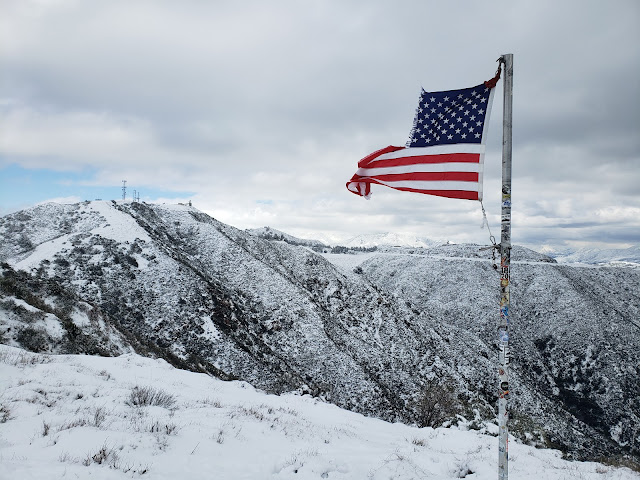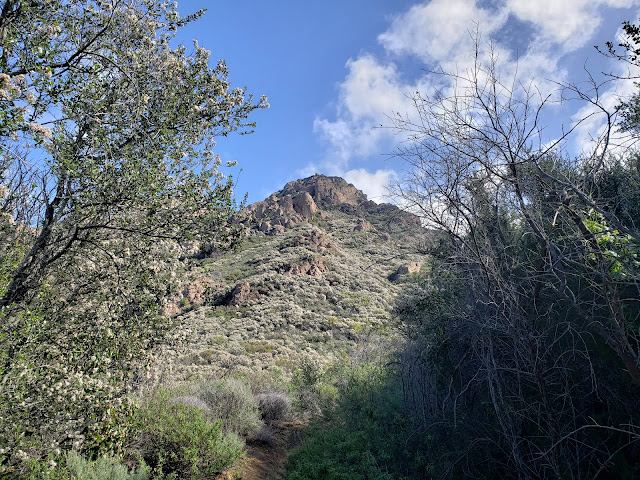Another outing with Sean "Cucamonga Man" Green and DavidR to an obscure point in the San Gabriel Range. This time, the goal was Pt. 7,296 at the terminal end of a lateral finger coming off the southeast side of Mt. Hawkins. The USGS topographic maps reference this point simply by its elevation. It apparently has not been formally christened. Because we found Bitterroot growing along the ridgeline, I'm calling the finger Bitterroot Ridge and its related fingernail Bitterroot Point.
The day started at the Windy Gap trailhead in Crystal Lake Recreation Area. A shorter route is possible from Dawson saddle, but with the Angeles Crest Highway closure, this was the only realistic option. I pulled into the spacious parking area at 7 a.m. and was fortunate to get a spot. The lot was crammed full as was the surrounding campground. I've never seen the forests like this. There's people everywhere. And with them has come trash and graffiti and vandalism and break-ins. Every sign post, bathroom, rock, and tree trunk has either been defaced or destroyed. My car has been broken into twice. You can say what you want about increased access, and sling all the insults like "elitist" or "gate-keeper" you want, but objectively the democratization of the outdoors has not been a net positive overall.
Fortunately, the blue morning was clear and beautiful and as we made the gentle climb away from the huddled masses, we were treated with stunning looks into the Crystal Lake basin. The tread here is in decent shape except a couple of spots that have been washed out by this season's heavy snow melt. About 2.5 miles and 1,800' later, we topped out at the notch where it was refreshingly breezy. They don't call it Windy Gap for nothing.
The path here intersects the Pacific Crest Trail as it traverses the San Gabriel range in an east-west orientation. Just west of this point, the PCT passes by reliable Little Jimmy spring and trail camp before descending to Islip Saddle. This is the route north-bound PCTers follow. We tacked east and followed the PCT against the grain for approximately 2 additional miles to the summit of Mt. Hawkins at 8,850'. Along the way, we encountered a couple of late season snow patches as well as a few downed trees blocking the way, but nothing that wasn't easily navigable. This is classic high-country territory dominated by conifers and sublime views of the Hawkins Ridge and the high desert to the north. The absence of distant road noise from the closed ACH was an extra-added bonus.
At Hawkins, we took a break, fueled up, and prepared ourselves for the drop down Copter Ridge and then into the unexplored. From the summit of Hawkins, the views are quite good and we spent a few moments identifying familiar landmarks like the Hawkins Ridge, the Islip Ridge, Mt. Waterman, the Twin Peaks, Triplets, Mt. Lawlor, Mt. Deception, Mt. Disappointment, San Gabriel Peak, Mt. Markham, Occidental Peak, Mt. Wilson, and the Ivy League Peaks (Harvard and Yale). We then cached some water and started down Copter Ridge which is now dotted with cairns and scarred by a not so faint use trail.
The standard route to Copter Ridge takes you straight south down the ridgeline to its terminus as Pt. 7,499. Around the 8,200' contour, we abandoned that trajectory and branched left (southeast) to follow the subsidiary ridge leading to Bitterroot Point. This is the point of no return. This is where you need to decide whether you have the juice to climb back out or not. Because if you commit, there is no easy way out. From this point, it's an additional 1,000' of elevation loss that is quite steep in places. Fortunately, the terrain is hospitable and open which makes travel less difficult than it might otherwise be. As you make your way toward the point, the Ross ridge looms in the immediate foreground while Pine Mountain, Dawson Peak, and the north side of Mt. Baldy sit sentinel in the rear-ground.
The ridge bottoms out at a grassy depression before a rocky outcropping that sits atop a small rise. This is Pt. 7,296 aka Bitterroot Point. Although the point is obvious and distinct, the ridge continues gently downward past this point into the depths of the Iron Fork. We paused here for a spell to enjoy the accomplishment, take in some food and water, and place a register. Then reluctantly started to retrace our steps back up the ridge.
Similar to upside-down hikes like Ross Mountain and Copter Ridge, the crux of this route is on the return trip. From Bitterroot Point, it's 1,000' of gain back to Copter Ridge and then another 600' back to Hawkins. The climb is mellow to start but then steepens significantly as you continue upward. The steepest section is immediately before you reclaim Copter Ridge. DavidR charged up the ridge like a big horn sheep, but I found myself having to stop every 25-50 yards to gain my breath and let the lactic acid in my legs dissipate. Back on Copter Ridge, the terrain moderates some, but I found that the last 600' of gain getting back to Hawkins to be the most physically demanding portion of the day.
Back on top Hawkins, we reclaimed our cached water and lounged in the brilliant high country sunlight. When we were good and ready, we took the "shortcut" off the summit and rejoined the PCT for an easy, yet long stroll back to the trailhead. To finish the day, we stopped at the Crystal Lake Café to drink carbonated beverages laced with caffeine and sugar in the shade, shoot the shit, and exaggerate the details about the day's exploits.
Stats for the day: ~13 miles, 4,600'
























































